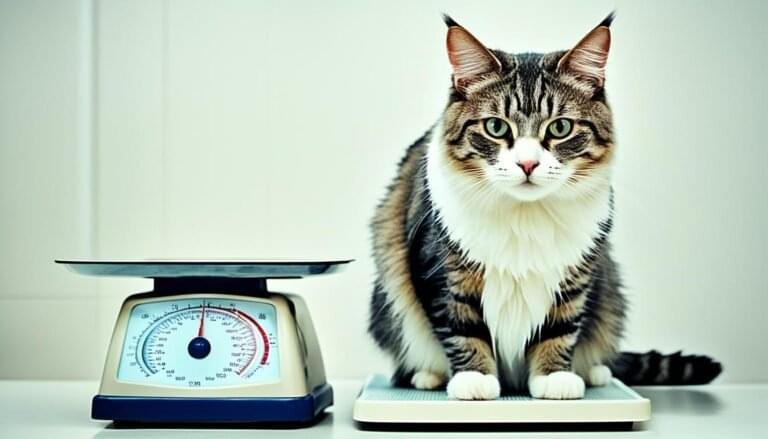How to Euthanize a Cat?: Did you know that euthanasia is a standard procedure offered by most veterinary hospitals in America? Whether it’s to alleviate a cat’s suffering or to provide a peaceful end to their life, euthanasia is an important aspect of feline healthcare. In this comprehensive guide, we will explore the humane ways to euthanize a cat and the considerations that go into making this difficult decision.
How to Euthanize a Cat?: Key Takeaways
- Recognize signs of suffering and consult with a veterinarian to assess the need for euthanasia.
- Important factors to consider when deciding to euthanize a cat include its quality of life and terminal conditions.
- Humane ways to euthanize a cat include home euthanasia with the assistance of a mobile veterinarian.
- Veterinary professionals play a vital role in providing a compassionate euthanasia experience.
- Aftercare and final arrangements for the cat’s body should be discussed and planned.
When to Consider Euthanizing a Cat
When it comes to considering euthanasia for a cat, it is crucial to carefully evaluate its quality of life. Various signs can indicate that it may be time to make this difficult decision. Here are some factors to consider:
- Immobility: If your cat is experiencing extreme difficulty in moving or appears to be in pain despite medical treatments or interventions, it may be an indication that euthanasia should be considered.
- Refusal to eat: Cats are generally known for their love of food. However, if your cat consistently refuses to eat and shows no interest in food or treats, it may be a sign of an underlying health issue, potentially terminal in nature. In such cases, euthanasia might be a humane choice.
- Obvious suffering: Visible signs of suffering, such as vocalizing in pain or showing signs of distress, should not be ignored. Constant discomfort or agony could indicate that euthanasia is the kindest option to relieve your cat from its suffering.
Additionally, terminal conditions or diseases that cause significant pain and discomfort may also warrant euthanasia. Consulting with a veterinarian is crucial to evaluate your cat’s condition, discuss available options, and make an informed decision about its end-of-life care.
Remember, euthanasia is a difficult decision that requires careful consideration of your cat’s well-being. It is important to prioritize their quality of life and consult with veterinary professionals to ensure the most compassionate approach.
| Signs to Consider | When to Consider Euthanasia |
|---|---|
| Immobility | If your cat is experiencing extreme difficulty in moving or appears to be in pain despite medical treatments or interventions. |
| Refusal to eat | If your cat consistently refuses to eat and shows no interest in food or treats. |
| Obvious suffering | If your cat exhibits visible signs of suffering, such as vocalizing in pain or showing signs of distress. |
Humane Ways to Euthanize a Cat
When it comes to euthanizing a cat, there are humane options available that prioritize their comfort and well-being. One such option is performing the procedure at home with the assistance of a mobile veterinarian. This allows the cat to remain in a familiar and comfortable environment during its final moments, reducing stress and anxiety.
The process typically involves administering a sedation injection to ensure the cat is relaxed and pain-free. This is followed by an intravenous injection that peacefully and painlessly puts the cat to sleep. By discussing the specifics of the procedure with a veterinarian, you can ensure that every effort is made to make the euthanasia experience as peaceful as possible for your cat.
Benefits of Peaceful Cat Euthanasia at Home:
- Comfort: Your cat can be in a familiar and secure environment during its final moments, promoting a sense of peace and tranquility.
- Reduced Stress: Cats can experience stress and anxiety when visiting a veterinary clinic. Performing euthanasia at home can minimize these distressing emotions.
- Privacy: By euthanizing your cat at home, you can have a private and intimate farewell without distractions or intrusions.
- Family Presence: Family members can gather around to say their goodbyes and provide comfort to the cat during its final moments.
Ultimately, the decision of where to euthanize your cat should be based on what you believe will provide the most peaceful and compassionate experience for your beloved pet. Discussing your options with a veterinarian will help you make an informed decision that aligns with your cat’s needs and your personal preferences.
The Role of Veterinary Professionals in Euthanasia Procedures
Veterinary professionals play a vital role in conducting euthanasia procedures for cats. They possess the necessary training and expertise to perform the procedure with compassion and skill. These professionals are well-versed in the standard guidelines set by the American Veterinary Medical Association, ensuring that the procedure is carried out safely and in line with industry best practices.
When considering euthanasia for your cat, it is important to consult with a veterinarian to discuss the procedure and any associated costs. The cost of cat euthanasia can vary depending on factors such as the veterinarian’s experience, the specific services provided, and the location of the veterinary clinic.
During the consultation, the veterinarian will also address any cat euthanasia considerations specific to your pet’s circumstances. They will assess the cat’s overall health, quality of life, and the presence of any underlying medical conditions that may influence the euthanasia decision. This thorough evaluation ensures that the well-being of the cat remains the priority throughout the process.
Evaluating the Cost of Cat Euthanasia
When discussing the cost of cat euthanasia with a veterinarian, it is essential to have a clear understanding of the services included. The cost may cover the euthanasia procedure itself, sedation or anesthesia, disposal of the cat’s remains, and any additional services such as a private cremation or burial.
Here is a breakdown of potential cost factors to consider:
| Cost Considerations | Explanation |
|---|---|
| Veterinary Fee | The professional fee charged by the veterinarian for performing the euthanasia procedure. |
| Sedation/Anesthesia | The cost of administering medications to ensure the cat’s comfort and relaxation during the procedure. |
| Disposal Method | The cost associated with the chosen method of disposition for the cat’s remains, such as communal cremation, private cremation, or burial. |
| Add-On Services | Additional services, such as paw prints, memorial keepsakes, or grief counseling, may incur extra charges. |
It is important to inquire about the total cost upfront to avoid unexpected expenses and allow for informed decision-making.
Remember, the cost of cat euthanasia should not be the sole determining factor in your decision-making process. Consider the cat’s well-being, quality of life, and the expertise and compassion provided by the veterinary professional. It is essential to choose a veterinarian whose values align with yours, guaranteeing a smooth and compassionate euthanasia experience for both you and your beloved cat.
Aftercare and Final Arrangements

After euthanasia, I understand that you’ll need to take care of your cat’s body and make final arrangements. Most veterinarians offer options for aftercare, ensuring a compassionate and respectful process. Here are some common options available:
- Cremation: Many pet owners choose cremation as a way to handle their cat’s remains. This option allows you to keep your cat’s ashes in an urn, preserving their memory in a tangible way.
- Home Burial: Some owners prefer to bury their cat at home, allowing them to be laid to rest in a familiar environment. This option provides a personalized and intimate final resting place.
If you choose cremation, you can also consider other ways to memorialize your beloved cat:
- Donating to Local Cat Rescue Services: Making a donation in your cat’s name can honor their memory and support other cats in need. It’s a meaningful way to give back and make a positive impact in their honor.
- Creating a Memorial: You can create a physical or virtual memorial to celebrate the life of your cat. This can include a photo collage, a personalized plaque, or even a dedicated webpage where you can share memories and stories.
Remember, these aftercare options are personal choices, and it’s essential to choose what feels right for you and your cat. Take the time to consider your preferences and consult with your veterinarian to explore the available options in your area.
Throughout this difficult process, it’s important to take care of yourself as well. Grieving the loss of a beloved pet can be challenging, and it’s normal to experience a range of emotions. Reach out to friends, family, or support groups to help navigate through this difficult time.
Support and Resources for Dealing with Grief
Dealing with the loss of a cat can be a challenging and emotional process. It is natural to feel a deep sense of grief and sadness during this time. However, you are not alone in your journey. There are resources available to help pet owners cope with their grief and find solace in the memories of their beloved cats.
One valuable resource is support groups specifically tailored for individuals who have experienced the loss of a pet. These groups provide a safe space for sharing your feelings, receiving empathy from others who have gone through a similar situation, and learning coping strategies from experts in pet bereavement.
If you prefer online communities, there are numerous forums and websites where you can connect with fellow pet owners who are grieving the loss of their cats. These virtual communities offer a sense of community, understanding, and support, even from the comfort of your own home.
In addition to support groups and online communities, there are various grief counseling services available. Grief counselors specialize in helping individuals navigate the complex emotions and challenges that arise from losing a beloved pet. They can provide a listening ear, offer guidance, and assist in processing your grief in a healthy and healing way.
Here are some resources you can explore to find support:
- Pet Loss Support Hotlines: Dialing a pet loss support hotline can connect you with compassionate professionals who are trained to provide comfort and guidance during this difficult time.
- National Directory of Pet Loss Support: This directory provides a comprehensive list of support groups, counselors, and other resources that cater specifically to individuals coping with pet loss. It allows you to search for services in your local area.
- Online Pet Bereavement Forums: These forums allow pet owners to connect with each other and share their experiences, stories, and coping mechanisms in a safe and empathetic environment.
Remember, each person grieves in their own way and at their own pace. It is important to be patient with yourself and allow yourself to feel the range of emotions that come with the loss of a beloved cat. Reach out for support, take care of yourself, and honor the memory of your feline companion.
| Resource | Description |
|---|---|
| Pet Loss Support Hotlines | Dedicated hotlines staffed by professionals who provide compassionate support for individuals experiencing pet loss. |
| National Directory of Pet Loss Support | An extensive directory listing support groups, counselors, and other resources tailored to pet loss. |
| Online Pet Bereavement Forums | Virtual communities where pet owners can connect, share their experiences, and find support during the grieving process. |
Ensuring a Compassionate and Stress-Free Euthanasia Experience

Providing a compassionate and stress-free euthanasia experience is crucial for both the cat and the owner. When it comes to cat euthanasia considerations, veterinary professionals should approach the procedure with empathy and understanding, recognizing the difficult decision the owners have made. By prioritizing the cat’s comfort and well-being, minimizing stress during cat euthanasia becomes a top priority.
One of the ways to minimize stress is by providing sedation or pain management for the cat. By ensuring the cat is relaxed and comfortable, it helps create a calm environment during the procedure. Clear communication between the veterinary professional and the owner is essential to ensure both parties understand the process and any concerns or questions are addressed.
An effective way to create a stress-free experience is by maintaining a calm environment. This includes minimizing external disturbances and creating a peaceful setting. Dimming the lights, playing soothing music, or using pheromone diffusers may help create a soothing atmosphere for the cat and the owner.
Additionally, taking the time to explain each step of the euthanasia process to the owner can help alleviate anxiety. This helps the owner feel more informed and involved, providing a sense of control during a difficult time.
By considering these cat euthanasia considerations and minimizing stress during cat euthanasia, veterinary professionals can ensure a compassionate and respectful experience for both the cat and the owner.
| Key Considerations for a Compassionate and Stress-Free Euthanasia Experience |
|---|
| Approach euthanasia with empathy and understanding |
| Provide sedation or pain management for the cat |
| Minimize external disturbances and create a calm environment |
| Communicate clearly with the owner |
| Explain each step of the process to the owner |
Ethical Considerations in Euthanizing a Cat
Euthanizing a cat is a sensitive topic that raises important ethical considerations for veterinary professionals. The well-being and quality of life of the cat must always be prioritized, ensuring that euthanasia is performed only when it is in the best interest of the animal.
Veterinarians adhere to ethical guidelines, which include considering the wishes and values of the owners when making decisions about euthanasia. Open and honest communication between the veterinarian, the owner, and any involved parties is crucial to ensure that everyone is well-informed and involved in the decision-making process.
By engaging in ethical considerations, veterinary professionals can ensure that the procedure is performed with compassion and care, taking into account both the physical and emotional well-being of the cat and its owner.
| Ethical Considerations in Euthanizing a Cat | Key Points |
|---|---|
| Prioritizing the well-being and quality of life of the cat | – Euthanasia performed when in the best interest of the animal – Ensuring the cat’s comfort and minimizing suffering |
| Adhering to ethical guidelines | – Considering the wishes and values of the owners – Balancing the cat’s needs with the owner’s preferences |
| Open and honest communication | – Involving the owner in decision-making – Providing information and support throughout the process |
By approaching euthanasia procedures with ethical considerations, veterinary professionals can navigate this challenging decision with empathy and respect, ensuring a dignified and compassionate end-of-life experience for the cat.
Conclusion
Deciding to euthanize a cat is a difficult choice, but it can be an act of compassion when the cat is suffering. Consultation with a veterinarian is crucial to evaluate the cat’s condition and explore the available options. Providing a peaceful and stress-free euthanasia experience is of utmost importance, and there are resources and support systems to help pet owners navigate the grief that follows. Ultimately, the decision to euthanize a cat should prioritize the animal’s well-being and quality of life.
Cat euthanasia considerations require careful thought and evaluation. It is essential to rely on the guidance and expertise of veterinary professionals to ensure that the cat’s needs are met. These professionals play a crucial role in performing the procedure and adhering to ethical guidelines. Open and honest communication throughout the process allows all parties involved to make well-informed decisions.
Remember, when facing the difficult decision of euthanizing a cat, it’s essential to prioritize the cat’s comfort and dignity. Compassion and empathy should guide the decision-making process, and support is available to pet owners during this emotional time. Reach out to your veterinarian, who can provide valuable guidance and resources, helping you make the best choice for your beloved feline companion.
FAQ
How do I know when it’s time to euthanize my cat?
What are the humane ways to euthanize a cat?
What is the role of veterinary professionals in euthanasia procedures?
What are the options for aftercare and final arrangements?
Where can I find support and resources for dealing with grief?
How can I ensure a compassionate and stress-free euthanasia experience for my cat?
What ethical considerations are involved in euthanizing a cat?
Where can I find additional information on cat euthanasia?
References
| International Cat Association (TICA) | https://www.tica.org/ |
| The Cat Fanciers’ Association (CFA) | https://cfa.org/ |
| World Cat Federation (WCF) | https://www.wcf-online.de/ |
| Fédération Internationale Féline (FIFe) | https://www.fifeweb.org/ |







